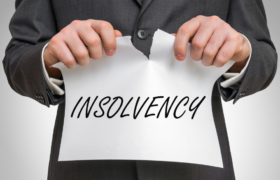Does it important enough that a corporation be placed into a formal insolvency plan under the Corporations Act because it is insolvent? According to the insolvency policy itself and the proposed amendments by the Australian government, it would appear not.

When I first started learning about insolvency, I decided to write an essay on the question, “Does insolvency matter?” I wanted to know if it really made a difference if a company was insolvent and if something should be done about it by entering it into a formal insolvency arrangement under the Corporations Act.
We concluded that insolvency in Australia and other countries suggests the opposite. Although there are aspects of bankruptcy that are in the public interest, the process itself is privatized, leaving the debtor and its creditors to determine the path to official insolvency.
The Australian Taxation Office comes the closest to playing the role of the grim reaper; its ‘draconian’ ability to issue penalty notices mandating that directors either put their company into insolvency within 21 days or face personal liability led us to argue that it was the true instigator and regulator of insolvencies in Australia.
In this article, our experienced insolvency lawyers Sydney explain all you need to know about legal proceedings on corporate insolvency and insolvent trading claims. We believe that with adequate knowledge about the bankruptcy act, personal insolvency agreements, restructuring insolvency, legal process, and how to get the best insolvency advice, our insolvency practitioners will make sure you are well-positioned to make good choices with your legal processes.
Insolvencies of MSME
These concerns are pertinent to the subject of what to do about the purportedly significant number of MSME insolvencies this and next year. There is a lot of speculation regarding whether or not the recently announced processes by the Australian government in September 2020 will actually be effective.
Many well-intentioned people have said that they hope that the processes that have been presented would be funded.
There will undoubtedly be some micro, small and medium-sized enterprises (MSMEs) that have survived the economic crisis brought on by COVID-19 and have the potential to be revitalized. However, we suspect that the vast majority of MSMEs are in fact bankrupt, with many creditors, employees, and unmet services and supplies but no assets or assets with any realizable value.
In the case of the latter, the directors have the option of:
- allowing a creditor to take winding-up action;
- walking away;
- declaring bankruptcy, in which case the shareholding vests in the bankruptcy trustee and the company becomes the trustee’s problem;
- attempting to find a liquidator willing to wind them up; or
- as a last resort, allowing ASIC to apply to wind them up.
Liquidators won’t take them on if they won’t be paid or come to some negotiated financial agreement (which can only happen in restricted situations, since creditors wouldn’t want to waste money on option 4), and option 3 can’t happen unless there are special conditions.
Option (1), walking away, is the most reasonable course of action since a director accepting the limits of a three-year Australian bankruptcy is an extreme response.
This phrase relates to the fact that the company’s directors can simply stop caring about it, at which point ASIC can deregister it under section 601AB, and the business “ceases to exist” under section 601AH of the Companies Act.
Would you agree that insolvency should be privatized?
Although ASIC statistics are difficult to come by, a 2016 estimate suggests that for every X number of formal external insolvency administrations each year under Ch 5 of the Corporations Act (liquidations, administrations, etc.), there is a 5X number of § 601AB deregistration.
We don’t know for sure if or to what degree any of these businesses were bankrupt, but we have a good idea that many of them were.
That reminds me; is it OK that insolvency is now a privately run process? Is it acceptable that thousands upon thousands of businesses will reappear in 2021 as ghosts, their assets reduced by pointless trading or by pre-emptive design, but with no itinerant grim reaper to enforce a winding up and an autopsy to ensure no foul play before they are buried?
The Numbers
Moreover, there are numbers gleaned from credible academic studies on our deregistered firms, conducted within the context of an investigation into illegal phoenix activity, which, as is well knowledge, entails dismantling the defunct company in the stealthiest manner possible.
That investigation uncovered a phoenix scenario in which an existing firm was sold to a new company and the old company was simply abandoned by its management without being liquidated (per § 601AB) and later deregistered by ASIC due to its lack of activity.
It is possible to re-register a deregistered corporation under section 601AH (5), however many do not bother since they do not have enough assets to pay for a liquidator. A successful reinstatement is quite improbable under these circumstances.
According to the scholarly work cited, the figures frequently cited, such as dividends on average of 11 cents or (much) less in 96% of cases, assets under $250,000, few employees, etc., are limited to the companies that we know about but only because they go through the formal insolvency process and data is extracted.
Members of staff and general unsecured creditors account for the bulk of these losses.
They will have to put up their own money to pay for the business’s liquidation if they want any chance of getting what they’re due back, and they may lose more if the company turns out to have no assets. So many creditors do nothing, and ASIC deregisters the company for non-payment of yearly fees or return of documentation.
According to the findings, the number of dormant businesses is five times higher than the number of liquidating businesses annually (as of 2016), however, the exact losses to creditors are unknown.
More than 20 years ago, in the ASC’s 1995 study report investigating Phoenix activities and insolvent trade, the possibility that poor oversight of the deregistration process may be aiding illicit Phoenix activity was recognized. This was commented on in a submission to the government in 2017.
Passing an anti-phoenix law, however, is far more convenient and effective. You can also read about Top Conveyancing firms in Sydney by visiting https://businessloangate.com/top-conveyancing-firms-in-sydney/
Is it Important Today?
For the time being, it’s important to address the issue of micro, small, and medium-sized enterprises (MSMEs) not having access to insolvency justice by creating a public function, such as a public liquidator or fund, to help them. Given the substantial gain granted a debtor by the discharge of all its debts, public faith and confidence in insolvency are shaky ideas.
Because of the widespread harm this causes, and because creditors aren’t likely to recoup much money through insolvency, it’s vital that those responsible face consequences—at least in Australia, where the rule of law is broadly supported, even by certain politicians.
Insolvency has never been about simply debtors and creditors and money, but the state still has a role to play in supporting the process by providing the necessary infrastructure.
Open data access, data collecting and analysis, and the application of artificial intelligence are some of the fundamentals needed, and an insolvency “business” that is already proficient in employing these tools is not ready in time for the crisis of 2020–2021. These are more areas for clarification, and we’ll get there as we go.
To sum up, the proposed changes as they stand do not deal with the issues of asset-less MSMEs, their creditors, and workers, or the challenges they have left behind.
Contact our insolvency professionals at Chamberlains to get started today, to know more about all your concerns on voluntary administration, the personal bankruptcy act, commercial disputes, bankruptcy trustees, insolvency administrations, and potential personal liability.


